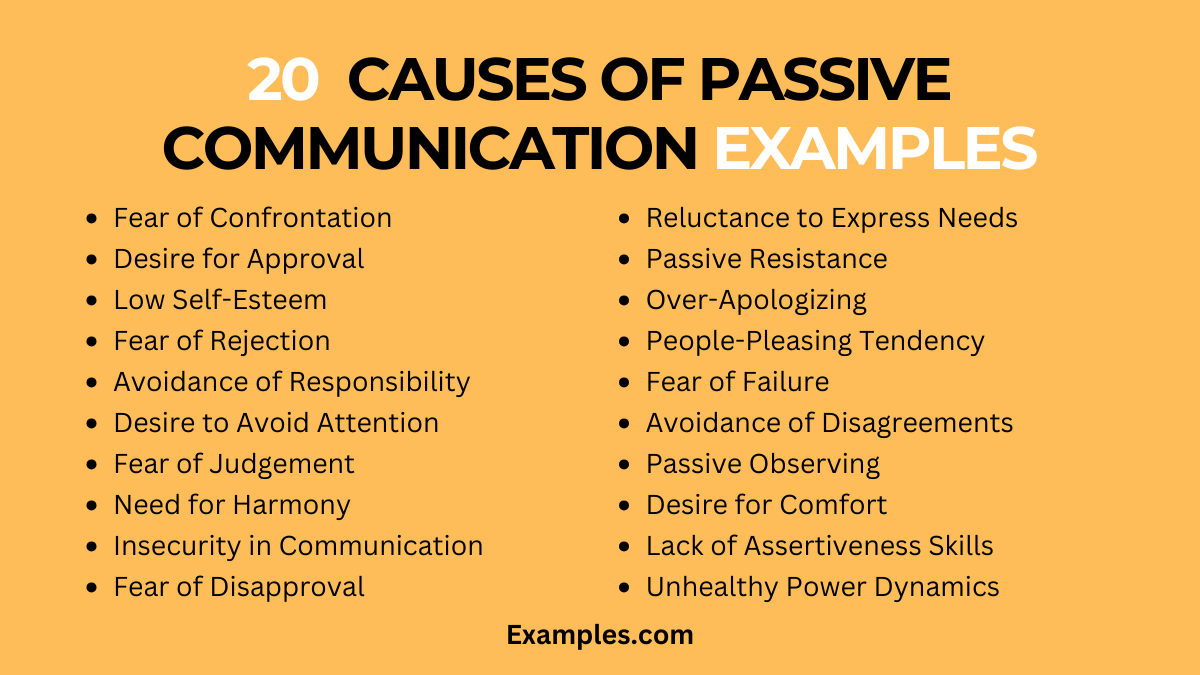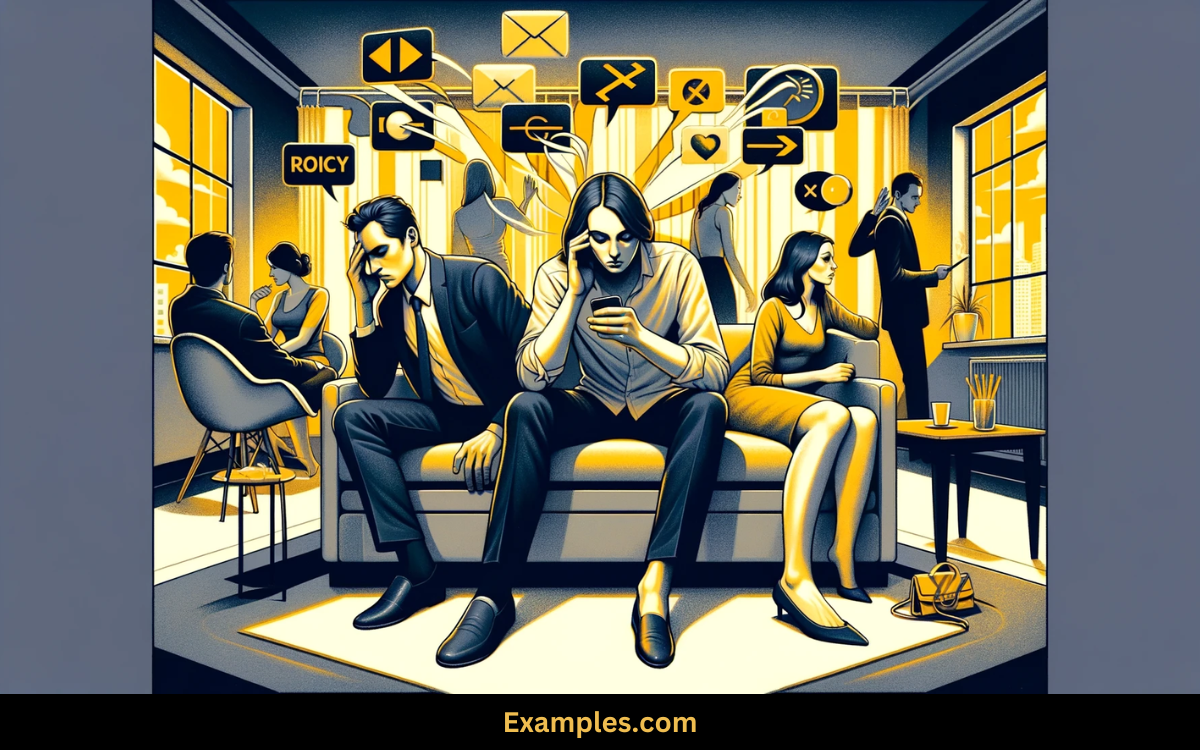Causes of Passive Communication
Embark on a journey through the intricacies of passive communication, dissecting its causes with real-world examples. This comprehensive guide sheds light on the roots of passivity, offering a nuanced understanding of why individuals adopt this communication style. Navigate through vivid scenarios to grasp the underlying causes and gain valuable insights to foster more effective and assertive communication.
What are the Causes of Passive Communication

Delve into the origins of passive communication by understanding its causes. In straightforward terms, passive communication arises from a reluctance to express oneself assertively. This behaviour often stems from a fear of conflict, a desire to avoid confrontation, or a lack of confidence. Uncover the intricacies of these causative factors, illuminating the reasons behind the adoption of a passive communication style. Decode the subtle triggers shaping interpersonal dynamics.
20 Causes of Passive Communication Examples
Explore the intricate causes of passive communication, unveiling 20 distinct triggers that shape this communication style. From fear of conflict to a desire for approval, understanding these causes is key to fostering effective communication. Dive into this guide to gain insights into the benefits of recognizing these triggers and elevate your interpersonal dynamics effortlessly.

- Fear of Confrontation:
- Example: Avoiding disagreements to prevent tension and maintain harmony.
- Desire for Approval:
- Example: Seeking validation and approval by conforming to others’ expectations.
- Low Self-Esteem:
- Example: Hesitating to express opinions due to a lack of confidence.
- Fear of Rejection:
- Example: Avoiding expressing personal feelings to prevent potential rejection.
- Avoidance of Responsibility:
- Example: Shying away from taking on responsibilities to evade potential mistakes.
- Desire to Avoid Attention:
- Example: Preferring to stay unnoticed, avoiding the spotlight in social settings.
- Fear of Judgement:
- Example: Hesitating to share ideas due to a fear of criticism or judgment.
- Need for Harmony:
- Example: Prioritizing harmony, even if it means suppressing personal opinions.
- Insecurity in Communication:
- Example: Using vague language to prevent potential misunderstandings.
- Fear of Disapproval:
- Example: Avoiding actions that may lead to disapproval from others.
- Reluctance to Express Needs:
- Example: Struggling to articulate personal needs or desires openly.
- Passive Resistance:
- Example: Resisting changes passively, without openly expressing concerns.
- Over-Apologizing:
- Example: Apologizing excessively, even when not at fault, to avoid conflict.
- People-Pleasing Tendency:
- Example: Prioritizing others’ needs over personal well-being.
- Fear of Failure:
- Example: Avoiding challenges or new opportunities due to a fear of failure.
- Avoidance of Disagreements:
- Example: Steering clear of disagreements to maintain a positive atmosphere.
- Passive Observing:
- Example: Observing situations passively without actively participating.
- Desire for Comfort:
- Example: Preferring comfort over taking risks or facing challenges.
- Lack of Assertiveness Skills:
- Example: Struggling to assert opinions or needs due to inadequate assertiveness skills.
- Unhealthy Power Dynamics:
- Example: Yielding to others to avoid power struggles or conflicts.
Causes of Passive Communication in Relationships
Delve into the complexities of passive communication’s influence on relationships. Examine causes such as fear of conflict, a desire for constant approval, and an aversion to disagreements. Unravel the subtle triggers shaping passive communication in personal connections, gaining valuable insights to navigate and strengthen relationships.

- Fear of Vulnerability:
- Withhold personal feelings to avoid appearing vulnerable.
- Seeking Constant Approval:
- Shape behaviour based on the constant need for approval.
- Avoidance of Disagreements:
- Steer clear of disagreements to maintain a positive relationship.
- Unhealthy Dependency:
- Over-reliance on the partner for decision-making to avoid responsibility.
- Reluctance to Express Needs:
- Struggle to articulate personal needs or desires openly.
Causes of Passive Communication at the Workplace
Uncover the roots of passive communication within the professional sphere. From a fear of confrontation to a reluctance to express ideas, these causes significantly impact workplace dynamics. Navigate through workplace-specific triggers, gaining insights to foster effective communication and collaboration.
- Fear of Confrontation at Work:
- Shy away from addressing conflicts to avoid tension.
- Desire for Approval in the Office:
- Seek validation by conforming to colleagues’ expectations.
- Reluctance to Express Ideas:
- Hold back innovative ideas during team discussions.
- Avoidance of Leadership Roles:
- Step away from leadership roles due to a preference for passivity.
- Difficulty Giving Constructive Feedback:
- Struggle to provide feedback due to fear of upsetting colleagues.
What are the issues with passive communication?
Discover the underlying issues intertwined with passive communication, dissecting the roots that contribute to its prevalence. This comprehensive guide navigates through various aspects, shedding light on the challenges and implications associated with adopting a passive communication style. Gain insights into the nuanced issues that hinder assertiveness, effective expression, and healthy interpersonal dynamics.
- Impaired Assertiveness: Passive communication often leads to a lack of assertiveness, hindering individuals from expressing their needs and opinions confidently.
- Misunderstandings and Ambiguities: The reluctance to communicate openly results in misunderstandings and vague expressions, fostering a communication environment filled with uncertainties.
- Strained Interpersonal Relationships: Passive communication contributes to strained relationships as individuals may struggle to address conflicts, leading to unresolved issues.
- Ineffective Problem-Solving: The avoidance of direct communication impedes effective problem-solving, as issues may linger without open discussion.
- Reduced Personal Growth Opportunities: Passivity limits personal growth by hindering individuals from expressing ideas, seeking feedback, and embracing new challenges.
In conclusion, this guide unravelled the intricate causes of passive communication, exposing the issues that hinder effective expression. By navigating through examples and insights, readers gained a profound understanding of the challenges associated with this communication style. Empower yourself to break free from passivity, fostering healthier relationships and a more assertive communication approach.



